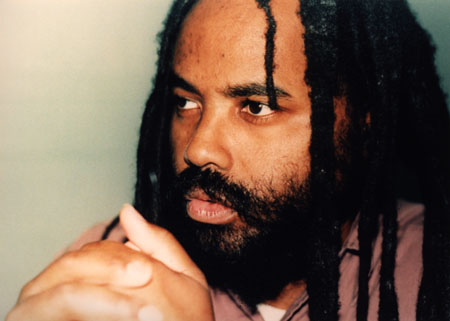Introduction
Mumia Abu-Jamal’s story is one of utter travesty and highlights the imperfections and fallibility of the American justice system. He is a Muslim African American who has spent the last thirty years in prison on Death Row in Pennsylvania and almost all of this time has been in solitary confinement. His case has attracted national and international attention and caused much controversy.
Mumia Abu-Jamal was tried, convicted and sentenced to death in 1982 for the murder of a police officer named Daniel Faulkner of the Philadelphia Police Department. This incident took place on 9 December 1981. Mumia Abu-Jamal was a journalist (had written articles critical of the authorities in Philadelphia) and political activist, as well as a cab driver in Philadelphia. He was also a former member of the Black Panther Party (BPP) and was under surveillance by the FBI’s Counterintelligence Programme, COINTELPRO. On the aforementioned date while he was driving his cab, he spotted his brother, William (Wesley) Cook in an altercation with the said police officer. He thereafter stepped in to assist his brother and during the struggle, Abu-Jamal and the policeman were both shot. Faulkner died at the scene and Abu-Jamal received non-fatal gunshot wounds to his chest. He has continued to maintain his innocence since 1981 and those advocating for his release or retrial have contested a substantial amount of the evidence used to obtain his conviction.
Now, Abu-Jamal is off death row, serving a life sentence with no chance of parole. This decision came about in late 2011 after years of appeals and the higher court declaring the death penalty verdict invalid. Whilst in prison, he has written hundreds of columns and articles and is the author of six books. They include vivid accounts of prison life and intellectual attacks on the criminal justice system.
The Relevant Law (from criminal.findlaw.com)
§ 1111. Murder
(a) Murder is the unlawful killing of a human being with malice aforethought. Every murder perpetrated by poison, lying in wait, or any other kind of wilful, deliberate, malicious, and premeditated killing; or committed in the perpetration of, or attempt to perpetrate, any arson, escape, murder, kidnapping, treason, espionage, sabotage, aggravated sexual abuse or sexual abuse, child abuse, burglary, or robbery; or perpetrated as part of a pattern or practice of assault or torture against a child or children; or perpetrated from a premeditated design unlawfully and maliciously to effect the death of any human being other than him, who is killed, is murder in the first degree.
Any other murder is murder in the second degree.
(b) Within the special maritime and territorial jurisdiction of the United States, Whoever is guilty of murder in the first degree shall be punished by death or by imprisonment for life;
Whoever is guilty of murder in the second degree, shall be imprisoned for any term of years or for life.
First-Degree Murder includes:
Wilful, deliberate, and premeditated murder.
Intent
In terms of wilfulness, first degree murderers must have the specific intent to end a human life. This intent does not necessarily have to have been focused on the actual victim. A murder in which the killer intends to kill but kills the wrong person or a random person would still constitute first degree murder.
Deliberation and Premeditation
Whether a killer acted with the deliberation and premeditation required for first degree murder can only be determined on a case by case basis. The need for deliberation and premeditation does not mean that the perpetrator must contemplate at length or plan far ahead of the murder. Time enough to form the conscious intent to kill and then act on it after enough time for a reasonable person to second guess the decision typically suffices. While this can happen very quickly, deliberation and premeditation must occur before, and not at the same time as the act of killing.
“Malice Aforethought”
Under many state laws, perpetrators of first degree murder must have acted with malice or “malice aforethought.” Malice generally includes an evil disposition or purpose and an indifference to human life. States treat the concept of “malice” differently. Under some laws, malice aforethought essentially means the same thing as acting with a premeditated intent to kill or extreme indifference to human life. Other states require a showing of malice distinct from the wilfulness, deliberation and premeditation generally required for first degree murder.
Overview of Pennsylvania First Degree Murder Laws
In Pennsylvania, criminal homicide, the unlawful death of a human being, includes three types of murder and two types of manslaughter. Pennsylvania state laws require proof of malice to distinguish murder from manslaughter. To prove malice in a murder case, the prosecutor must show the defendant’s general intent to commit an unlawful act or achieve a harmful result. A prosecutor can establish either express malice or implied malice; first degree murder generally requires a showing of express malice.
Furthermore, the prosecutor must prove that the defendant had a specific intent to kill. In a first degree murder case, the state may prove the defendant’s deliberate intent to commit an unlawful killing by considering the defendant’s actions, use of a deadly weapon, or other circumstances.
Example: Use of a deadly weapon may demonstrate a specific intent to kill. For example, the prosecutor might show that the defendant shot the victim in a vital area with a handgun.
Example: Use of deadly force may also show the defendant’s specific intent to kill. For example, the prosecutor might show that the defendant chose to strangle the victim forcefully.
First degree murder is the highest degree of murder in Pennsylvania and normally results in the most punitive punishments available under state law. To prove first degree murder, the prosecutor must show that the defendant committed a premeditated, unlawful killing of a human being. The defendant’s premeditation, planning, and deliberate acts set first degree murder apart from second degree murder. A killing committed spontaneously or during a heat of passion may likely require prosecution as one of the other homicide crimes established by Pennsylvania law.
Appeals and reviews history
State appeals (first stage of appeals)
Direct appeal of Abu-Jamal’s conviction was considered and denied by the Supreme Court of Pennsylvania on March 6, 1989, subsequently denying rehearing. The Supreme Court of the United States denied his petition for writ of certiorari on October
1, 1990 and denied his petition for rehearing twice up to June 10, 1991.
The six judges of the Supreme Court of Pennsylvania unanimously ruled that all issues raised by Abu-Jamal, including the claim of ineffective assistance of counsel, were without merit. The Supreme Court of the United States denied a petition for certiorari against that decision on October 4, 1999, enabling Tom Ridge (Pennsylvania Governor) to sign a second death warrant on October 13, 1999. As a result, the execution was stayed as Abu-Jamal began his pursuit of federal habeas corpus review.
In 2008, the Supreme Court of Pennsylvania rejected a further request from Abu-Jamal for a hearing into claims that the trial witnesses perjured themselves on the grounds that he had waited too long before filing the appeal.
On March 26, 2012 the Supreme Court of Pennsylvania rejected his most recent appeal for retrial argued on the basis that a 2009 report by the National Academy of Science demonstrated that forensic evidence put by the prosecution and accepted into evidence in the original trial was unreliable.
Federal appeal (second stage of appeal)
On December 6, 2005, the Third Circuit Court admitted four issues for appeal of the ruling of the District Court:
(1) in relation to sentencing, whether the jury verdict form had been flawed and the judge’s instructions to the jury had been confusing;
(2) in relation to conviction and sentencing, whether racial bias in jury selection existed to an extent tending to produce an inherently biased jury and thus an unfair trial (the Batson claim);
(3) in relation to conviction, whether the prosecutor improperly attempted to reduce jurors’ sense of responsibility by telling them that a guilty verdict would be subsequently vetted and subject to appeal; and
(4) in relation to post-conviction review hearings in 1995–6, whether the presiding judge, who had also presided at the trial, demonstrated unacceptable bias in his conduct.
On March 27, 2008, the three-judge panel issued a majority 2–1 opinion upholding Judge Yohn’s 2001 opinion but rejecting the bias and Batson claims, with Judge Ambro dissenting on the Batson issue. On July 22, 2008, Abu-Jamal’s formal petition seeking reconsideration of the decision by the full Third Circuit panel of 12 judges was denied. On April 6, 2009, the United States Supreme Court also refused to hear Abu-Jamal’s appeal. On January 19, 2010, the Supreme Court ordered the appeals court to reconsider its decision to rescind the death penalty, with the same three-judge panel convening in Philadelphia on November 9, 2010, to hear oral argument. On April 26, 2011, the Third Circuit Court of Appeals reaffirmed its prior decision to vacate the death sentence on the grounds that the jury instructions and verdict form were ambiguous and confusing.
In December 2011, the death penalty was dropped.
The current update (from www.freemumia.com)
On February 25, 2013, Mumia’s legal team filed an appeal in the Pennsylvania Superior Court challenging his sentence of life imprisonment without parole.
The brief demonstrates that the trial court violated state and federal law:
>by resentencing Mumia without providing him, his counsel or anyone else notice that a resentencing would occur
>by failing to give Mumia or his counsel the opportunity to appear or present information or argument prior to sentencing, and
>by failing to make any effort to ensure that Mumia was informed of his appellate rights
An opinion/ruling awaits.
Conclusion
The proceedings used to convict and sentence Mumia Abu-Jamal to death were in violation of minimum international standards that govern fair trial procedures including the use of the death penalty. Over the years, he has built up support from a wide selection of people and officials ranging from distinguished human rights organisations, to heads of states and prominent politicians worldwide. Supporters of Abu-Jamal maintain his innocence and believe he was and is a victim of a corrupt system. It can be argued that he has now become an international symbol for institutional racism and judicial abuse.
Continued support is needed to ensure this man’s death is not met behind bars. His experience of on-going injustice must be brought to an end and his fight for freedom be given a fair stage. Let him not remain a life in the balance.
SOURCES:
http://www.freemumia.com/who-is-mumia-Abu-Jamal/
http://www.freemumia.com/2013/03/25-feb-2013-important-legal-update/
http://www.bbc.co.uk/news/magazine
http://journalists4mumia.blogspot.co.uk
http://www.sff.net/people/tbisson/mumia.html
http://www.workers.org/articles/2013/08/25/Ralph-pointer-visits-mumia-Abu-Jamal/
The Yale Law Journal Company, Inc, Tethering on the Brink: Between Death and Life, Mumia Abu-Jamal




